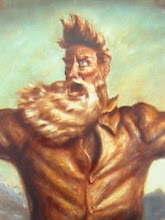As I said in my last post, the Darwin Hills are like Swiss cheese. There are holes everywhere. Silver and lead were the primary materials mined through the years, though gold, talc tungsten and other minerals were mined as well.
I have been trying to figure out what each of the mines we visited were named and what was mined there. I have had limited success, many of the mines haven't been worked for 70 years or more. Many have changed names, others have vague locations or descriptions in what little literature exists about them.
Despite my difficulty in researching them, I thoroughly enjoyed visiting and exploring them. Although most are heavily damaged and/or vandalized, there is more left intact than in other mining areas that I have visited. I suspect that is due to the remoteness of the Darwin area and it's distance from any population areas.
Do us both a favor and click on the images to view a larger format.
The above hopper is located in the canyon just below our camp. I literally stumble upon it while going for a photo walk on morning before breakfast.
I am a real sissy when it comes to messing around old mines. They are inherently dangerous, occasionally so dangerous that people have been left to die in them as there was no safe way to accomplish a rescue. Thus, it has to appear to be really bombproof before I will enter a mine.
Some tunnels are just straight holes into a side of a hill. I suspect that these are prospect holes, ones just looking to see what minerals are contained in the mountain.
The photo below was taken from inside one such tunnel. It went straight in for about 200 feet. The opening was almost large enough to drive in, though it narrowed down pretty quick. My friend and his dog went with me into the tunnel, our wives stayed in my jeep as it was only in the forties.
A lot of times, we don't get anywhere near the adit because it is sealed up, too dangerous or a pain to get to. Interesting structures and remains can still be found though, presenting many photo opportunities.
Some openings are vertical shafts that go down for hundreds of feet. These types of mines have claimed a few lives over the years, swallowing unsuspecting hikers and dirt bikers.
Sometimes there is nothing left of the operation, just tailings. Whether it's the setting, the view, the trip or the fun of exploring new areas with friends, it's still a great time.
You never know what you will find either. Rumor has it that Jimmy Hoffa went into the witness protection program and got a job driving a school bus for the Inyo County School District. One day he didn't return from his route after dropping all of the kids off. They found the bus, but they never found him. There is a lot of old mine shafts nearby maybe he is at the bottom of one of them. I'm just sayin'.
We explored the headworks of a mine on our way back to camp. The stop provided a couple of surprises. The first was the sun setting on a ridge several miles away.
The other was what we found on the back side of an equipment shack left on the claim.
At first I thought that someone had gone crazy with a paintball gun. It turned out that someone had just gone crazy with some cans of paint. Out of place as it was, it was also kind of fitting.
The next morning, we set out again and went to a large mine complex located on the east side of the Darwin Hills.
Note two things. First, the plank flooring. Second, the light at the end of the tunnel.
I saw the planking and didn't like what I saw. There was a spot where an access hole had been removed. The view sent a shiver down my spine.
That's looking straight down, farther than my flash can light it up. Although most of the shoring system appeared to be intact, a small section of it appears to be damaged. That was enough for me, out I went. One of my friends is pretty familiar with this mine, he has been coming here for years. He was comfortable with walking out to the end, keeping to the left of the tunnel where a ledge of rock was left to support the planks. I was not.
Remember the light at the end of the tunnel? Look where it comes out.
The larger of the two visible holes is the light visible at the end of the tunnel in the photo above. The photo below is of the same hole, only zoomed out to give a better perspective of the immense size of this pit.
My lens wouldn't widen enough to get it all and the terrain wouldn't allow me to get any farther back - the pit is just that big.
The other part of this mine was stable rock, fairly level and relatively safe. Perfect for exploring.
There were several other levels, ones that we had no way to access. Who knows what artifacts exist down there?
As it was, there was plenty to see.
Even though the tunnels were relatively stable, there was still quite a bit of wood underground. Even if some knucklehead doesn't burn it down, someday it will collapse, permanently closing off part of the mine.
This was one of the better mines that I have been in. It made for a great morning.
Thanks to Eric for showing us around the mine, thanks to you for reading.
Schmoe
Friday, November 16, 2012
Subscribe to:
Post Comments (Atom)
.jpg)
.jpg)
.jpg)
.jpg)
.jpg)
.jpg)
.jpg)

.jpg)
.jpg)
.jpg)
.jpg)
.jpg)
.jpg)
.jpg)
.jpg)
.jpg)
.jpg)
.jpg)
.jpg)


No comments:
Post a Comment